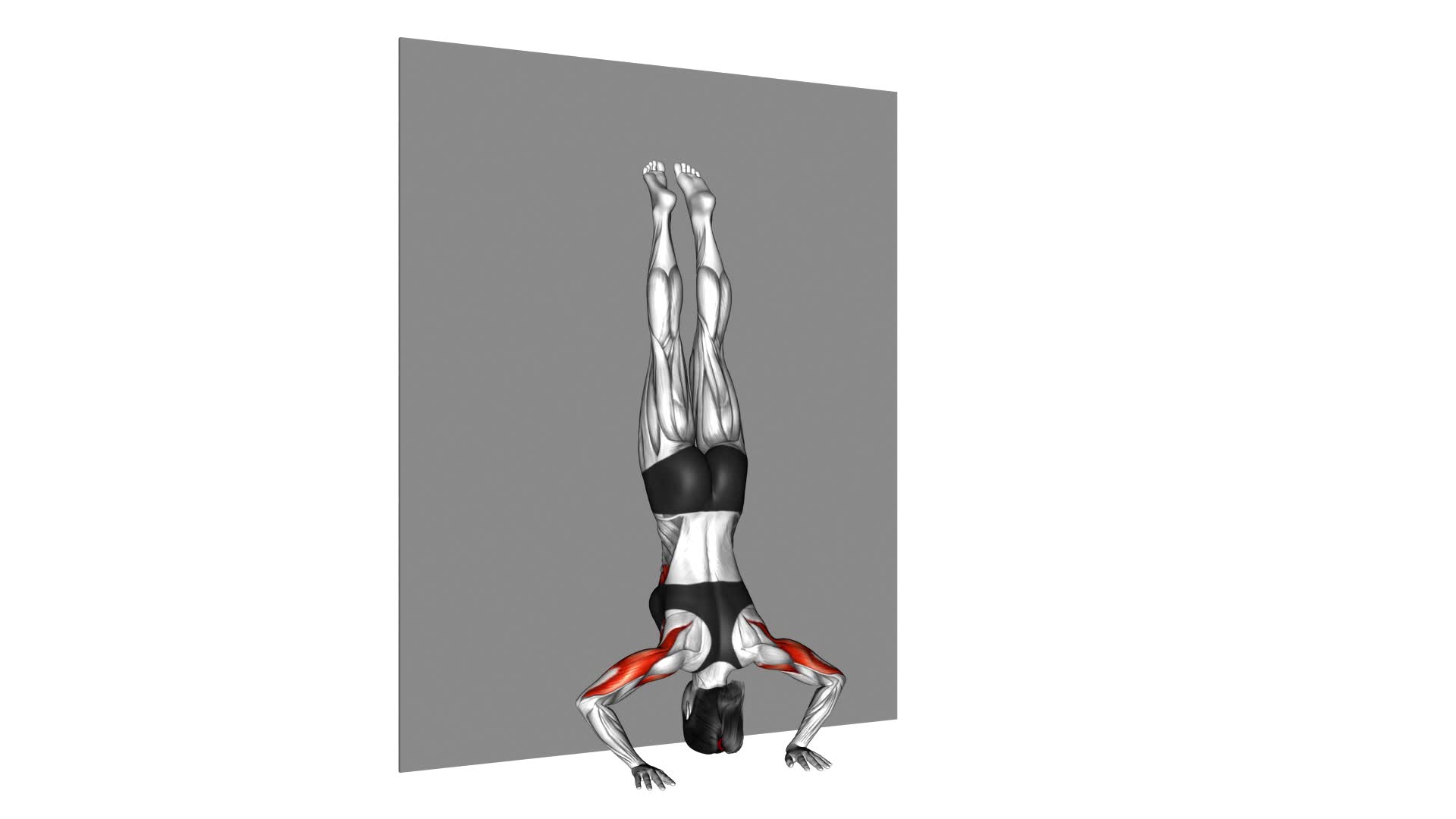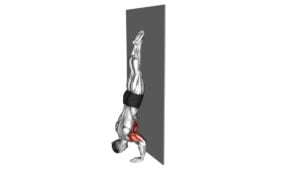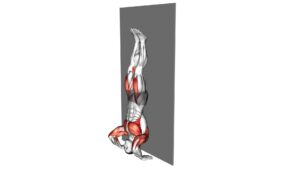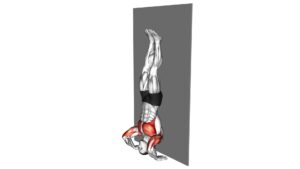Handstand Push-Up (female) – Video Exercise Guide & Tips

Looking to strengthen your upper body and challenge yourself? Check out our video exercise guide and tips for the handstand push-up! This advanced move targets your shoulders, triceps, and core, and is a great way to build strength and stability.
Watch This Exercise Video
In this guide, we'll show you proper alignment and technique, scaling options for beginners, and advanced variations to push your limits. Avoid common mistakes, prevent injuries, and recover effectively with our expert advice.
Let's get started!
Key Takeaways
- Handstand push-ups target shoulders, triceps, and core muscles.
- Proper alignment and technique are crucial to maximize benefits and minimize injury risk.
- Beginners can start with modified versions and gradually progress towards full handstand push-ups.
- Advanced variations can challenge strength, balance, and body control.
Benefits of the Handstand Push-Up
You can experience significant strength gains and improved shoulder stability by incorporating handstand push-ups into your fitness routine. The benefits of handstand push-ups extend beyond just building upper body strength. This challenging exercise requires proper alignment and engages multiple muscle groups simultaneously.
One of the main benefits of handstand push-ups is their ability to target and strengthen your shoulder muscles. As you push yourself up from the ground, your shoulders bear the weight of your body, effectively working the deltoids, trapezius, and rotator cuff muscles. This can lead to increased shoulder stability and reduced risk of injury.
Handstand push-ups also engage your core muscles, including the abs and lower back. As you balance in the handstand position, your core must work to keep your body stable and aligned. This not only improves your overall balance but also strengthens your core muscles.
Additionally, handstand push-ups require strong arm and upper body strength. By regularly incorporating this exercise into your routine, you can expect to see improvements in your triceps, biceps, and chest muscles.
To reap the full benefits of handstand push-ups, it's crucial to maintain proper alignment throughout the movement. This means keeping your body straight and your core engaged, avoiding excessive arching or bending at the hips. Proper alignment ensures that you're effectively targeting the intended muscle groups and minimizing the risk of injury.
Incorporating handstand push-ups into your fitness routine can provide you with significant strength gains, improved shoulder stability, and overall upper body development. Remember to focus on proper alignment to maximize the benefits and minimize the risk of injury.
Proper Alignment and Technique
Maintain proper alignment and execute the handstand push-up with precision and control. To ensure injury prevention and maximize the effectiveness of this exercise, it's essential to warm up properly. Here are some warm-up techniques to consider:
- Dynamic stretching: Perform dynamic movements that mimic the actions of the handstand push-up, such as shoulder circles and arm swings, to increase blood flow and joint mobility.
- Core activation exercises: Engage your core muscles with exercises like plank variations or hollow body holds to stabilize your body during the handstand push-up.
- Shoulder mobility exercises: Incorporate exercises that target the rotator cuff and scapular muscles, such as external rotations and scapular retractions, to enhance shoulder stability and range of motion.
- Wrist warm-up: Prioritize wrist mobility exercises, such as wrist circles and wrist extensions, to prepare your wrists for the weight-bearing load of the handstand push-up.
- Gradual progression: Start with modified versions of the handstand push-up, such as pike push-ups or wall-assisted handstand push-ups, before attempting the full movement.
Scaling and Progressions for Beginners
Are you unsure how to scale and progress as a beginner in the handstand push-up? Scaling modifications and building strength are key factors in mastering this challenging exercise. As a beginner, it's important to start with modified versions of the handstand push-up to gradually build strength and improve your technique.
One scaling modification for beginners is to perform the exercise with your feet supported on a raised surface, such as a box or bench. This reduces the amount of weight you have to lift and allows you to focus on maintaining proper form and building strength in your upper body.
Another modification is to perform pike push-ups. In this variation, you start in a push-up position with your hips lifted high in the air, creating an upside-down V shape. From there, you bend your elbows to lower your head towards the ground and then press back up to the starting position. This modification helps to build the foundational strength needed for the handstand push-up.
By consistently practicing these scaling modifications and gradually increasing the difficulty over time, you'll be able to progress towards performing the full handstand push-up. Once you feel comfortable with these modifications, you can begin exploring advanced variations to challenge yourself even further.
Next, let's dive into the exciting world of advanced variations to challenge yourself and take your handstand push-up to the next level.
Advanced Variations to Challenge Yourself
Now that you've mastered the basics, it's time to push yourself with some advanced variations of the handstand push-up.
One option is the one-arm handstand modification, which requires incredible strength and balance.
Another challenging variation is the pike push-up progression, where you'll be working your shoulders and core in a new way.
Lastly, you can try the wall-assisted handstand push-up to challenge your upper body strength even further.
These variations will take your handstand push-up to the next level and help you reach new heights in your fitness journey.
One-Arm Handstand Modification
To challenge yourself and take your handstand practice to the next level, try incorporating advanced variations of the one-arm handstand. These modifications won't only test your strength and balance, but they'll also provide a range of benefits for your body and mind.
Here are five advanced variations of the one-arm handstand to challenge yourself with:
- One Arm Handstand Push-Up: This variation adds an additional level of difficulty by incorporating a push-up into the movement.
- Straddle One Arm Handstand: By spreading your legs apart in a straddle position, you'll challenge your core stability and increase the demand on your shoulders.
- One Arm Handstand Walk: Take your one-arm handstand on the move and challenge your balance and control by walking on your hands.
- One Arm Handstand Press: This variation requires you to press up into a one-arm handstand from a seated position, testing your upper body strength and control.
- One Arm Handstand Hold: Once you have mastered the one-arm handstand, challenge yourself to hold the position for longer durations to improve your balance and stability.
Incorporating these advanced variations into your handstand practice won't only provide a thrilling challenge, but also help you reap the benefits of improved strength, balance, and body control.
Pike Push-Up Progression
Challenge yourself with advanced variations of the pike push-up to further progress your handstand practice and increase the intensity of your upper body workout.
These advanced variations not only challenge your shoulder stability but also help you develop the strength and control necessary for handstand progression.
One variation is the pike push-up with elevated feet. Start in a downward dog position with your feet on an elevated surface, such as a bench or box. Lower your head towards the ground by bending your elbows, keeping your body in a straight line. Push back up to the starting position.
Another variation is the pike push-up with one leg elevated. Perform a regular pike push-up, but elevate one leg off the ground. This increases the demand on your shoulders and core.
Incorporate these advanced variations into your workout routine to take your handstand practice to the next level.
Wall-Assisted Handstand Push-Up
As you progress in your handstand practice and continue to challenge yourself, the wall-assisted handstand push-up offers advanced variations to further enhance your upper body strength and control. Here are five variations to take your handstand progressions to the next level and develop exceptional shoulder strength:
- Wall-Assisted Pike Push-Up: Start in a pike position with your feet against the wall. Lower your head towards the ground, keeping your elbows close to your body. Push back up to the starting position.
- Wall-Assisted Straddle Push-Up: Position yourself in a straddle handstand with your feet on the wall. Bend your arms to lower your head towards the ground, then press back up.
- Wall-Assisted Tuck Push-Up: Begin in a tucked handstand with your knees bent. Lower your head towards the ground, maintaining control, and push back up.
- Wall-Assisted Diamond Push-Up: Place your hands close together, forming a diamond shape. Lower your head towards the ground, keeping your elbows tight. Push back up.
- Wall-Assisted One-Leg Pike Push-Up: Assume a pike position with one leg extended and the other against the wall. Perform a push-up, focusing on maintaining balance and control.
Common Mistakes to Avoid
Avoid arching your back excessively during the handstand push-up. This is one of the most common mistakes people make when performing this exercise. Not only does it compromise your form, but it also puts unnecessary strain on your lower back and increases the risk of injury.
Maintaining a straight line from your head to your heels is crucial for proper execution. To avoid arching your back, engage your core muscles and focus on keeping your body in a straight position throughout the movement. Imagine that there's a plank of wood running along your spine, keeping it aligned and preventing any excessive curvature.
Another mistake to avoid is flaring your elbows out to the sides. This places excessive stress on the shoulders and can lead to discomfort or injury. Instead, keep your elbows tucked in close to your body as you lower yourself down and push back up. This will help maintain proper shoulder alignment and reduce the risk of strain.
Lastly, rushing through the exercise is another common mistake. Take your time and perform each rep with control and precision. This won't only improve your form but also maximize the effectiveness of the exercise.
Tips for Injury Prevention and Recovery
To prevent injuries during handstand push-ups, it's crucial to focus on proper form techniques. This includes maintaining a straight body alignment, engaging your core, and avoiding excessive strain on your neck and shoulders.
Additionally, make sure to incorporate stretching and warm-up exercises before attempting handstand push-ups to increase flexibility and reduce the risk of muscle strains.
Lastly, don't forget to prioritize rest and recovery to allow your muscles time to repair and strengthen, which will ultimately help prevent overuse injuries.
Proper Form Techniques
Your proper form technique for injury prevention and recovery starts with maintaining a strong and stable handstand position. Here are some essential tips to help you prevent injuries and recover effectively:
- Warm up properly before attempting handstand push-ups. Incorporate dynamic stretches and mobility exercises to prepare your shoulders, wrists, and core.
- Engage your core muscles throughout the exercise to stabilize your body and prevent strain on your lower back.
- Keep your shoulders packed and wrists stacked directly under your shoulders to maintain proper alignment and avoid unnecessary stress on your joints.
- Maintain a straight line from your head to your heels, ensuring that your body remains in a vertical position throughout the movement.
- Start with proper progressions and gradually increase the difficulty of the exercise to avoid overloading your muscles and joints.
Stretching and Warm-Up
Before attempting handstand push-ups, make sure to properly stretch and warm up to prevent injuries and aid in recovery.
Warm-up techniques are crucial to prepare your muscles and joints for the demands of the exercise. Start with a few minutes of light cardio, like jogging or jumping jacks, to increase blood flow and raise your body temperature.
Then, focus on dynamic stretches that target the muscles used during handstand push-ups, such as shoulder circles and arm swings. These stretches help to improve flexibility and range of motion.
Additionally, incorporate static stretches after your workout to promote muscle recovery and prevent tightness.
Remember to listen to your body and avoid pushing beyond your limits to avoid injuries.
Now, let's move on to the next section about rest and recovery.
Rest and Recovery
Make sure you prioritize rest and recovery to prevent injuries and aid in your overall fitness journey. Here are some important tips for injury prevention and recovery:
- Listen to your body: Pay attention to any signs of pain or discomfort and adjust your training accordingly. Rest when needed.
- Get enough sleep: Adequate sleep is crucial for muscle repair and overall recovery. Aim for 7-9 hours of quality sleep each night.
- Hydrate properly: Staying hydrated helps maintain muscle function and prevents cramps. Drink plenty of water throughout the day.
- Incorporate active recovery: Engage in low-intensity activities like walking or yoga on rest days to promote blood flow and enhance recovery.
- Follow a balanced diet: Proper nutrition is essential for muscle recovery and injury prevention. Ensure you're consuming enough protein, carbohydrates, and healthy fats.
Frequently Asked Questions
How Long Does It Take to Master the Handstand Push-Up?
To master the handstand push-up, it takes time and practice. Don't worry if you're a beginner, as handstand push-ups can be modified to suit your fitness level.
One common mistake to avoid isn't engaging your core, which is crucial for stability. Another mistake is rushing the movement and sacrificing proper form. Take your time, focus on technique, and gradually increase your strength and balance.
With dedication, you'll be nailing those handstand push-ups in no time!
Can Handstand Push-Ups Help Improve Shoulder Stability?
Handstand push-ups are an excellent exercise to improve shoulder stability. By challenging your upper body strength and balance, they help strengthen the muscles surrounding your shoulder joint.
Incorporating variations of handstand push-ups, such as pike push-ups or wall-assisted handstand push-ups, can further enhance your shoulder stability and target different muscle groups.
Consistent practice and proper form are key to mastering this exercise and reaping its benefits for shoulder strength and stability.
Are There Any Modifications for Individuals With Wrist Pain or Injuries?
If you're experiencing wrist pain or have a wrist injury, there are modifications you can make to the handstand push-up exercise. Instead of putting weight on your hands, focus on wrist strengthening exercises to improve stability.
Additionally, there are alternative exercises that can help strengthen your shoulders without putting strain on your wrists.
It's important to listen to your body and consult with a professional to ensure you're performing the exercises safely and effectively.
What Muscles Are Primarily Targeted During the Handstand Push-Up?
During a handstand push-up, your primary muscles targeted are the shoulders, triceps, and upper back. This challenging exercise can be modified to fit your fitness level, allowing you to progress and build strength over time.
Handstand push-ups offer numerous benefits, including improved shoulder stability, increased upper body strength, and enhanced core engagement.
Can Handstand Push-Ups Be Done Without a Wall for Support?
Yes, handstand push-ups can be done without a wall for support. There are variations and progressions that can help you build the strength and balance required.
Start by practicing against a sturdy surface, like a countertop or a chair, then gradually work your way up to doing them freestanding.
It's important to focus on maintaining proper form and engaging your core throughout the movement.
With consistency and patience, you can master handstand push-ups without the need for a wall.
Conclusion
In conclusion, the handstand push-up is a challenging exercise that offers numerous benefits, including increased upper body strength and stability.
By maintaining proper alignment and technique, beginners can gradually progress and achieve this advanced movement.
Advanced variations provide a greater challenge for those seeking to push their limits. However, it's important to avoid common mistakes and prioritize injury prevention.
With proper form and consistency, the handstand push-up can be a valuable addition to any fitness routine.

Author
Years ago, the spark of my life’s passion ignited in my mind the moment I stepped into the local gym for the first time. The inaugural bead of perspiration, the initial endeavor, the very first surge of endorphins, and a sense of pride that washed over me post-workout marked the beginning of my deep-seated interest in strength sports, fitness, and sports nutrition. This very curiosity blossomed rapidly into a profound fascination, propelling me to earn a Master’s degree in Physical Education from the Academy of Physical Education in Krakow, followed by a Sports Manager diploma from the Jagiellonian University. My journey of growth led me to gain more specialized qualifications, such as being a certified personal trainer with a focus on sports dietetics, a lifeguard, and an instructor for wellness and corrective gymnastics. Theoretical knowledge paired seamlessly with practical experience, reinforcing my belief that the transformation of individuals under my guidance was also a reflection of my personal growth. This belief holds true even today. Each day, I strive to push the boundaries and explore new realms. These realms gently elevate me to greater heights. The unique combination of passion for my field and the continuous quest for growth fuels my drive to break new ground.







